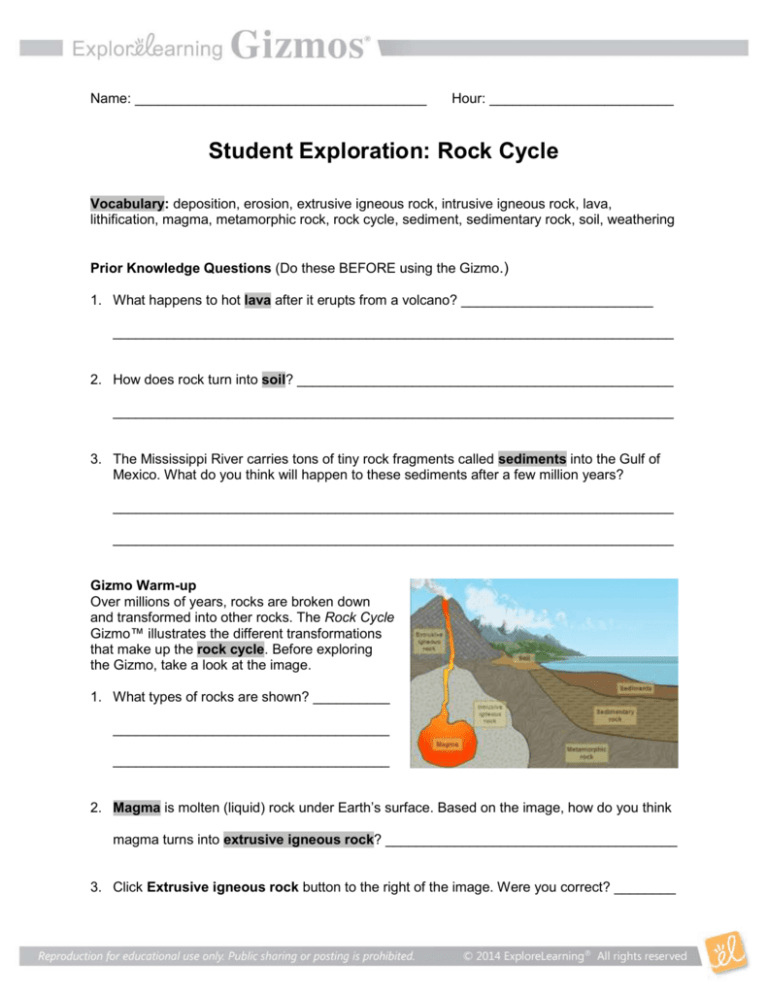Rock Cycle
advertisement

Name: ______________________________________ Hour: ________________________ Student Exploration: Rock Cycle Vocabulary: deposition, erosion, extrusive igneous rock, intrusive igneous rock, lava, lithification, magma, metamorphic rock, rock cycle, sediment, sedimentary rock, soil, weathering Prior Knowledge Questions (Do these BEFORE using the Gizmo.) 1. What happens to hot lava after it erupts from a volcano? _________________________ _________________________________________________________________________ 2. How does rock turn into soil? _________________________________________________ _________________________________________________________________________ 3. The Mississippi River carries tons of tiny rock fragments called sediments into the Gulf of Mexico. What do you think will happen to these sediments after a few million years? _________________________________________________________________________ _________________________________________________________________________ Gizmo Warm-up Over millions of years, rocks are broken down and transformed into other rocks. The Rock Cycle Gizmo™ illustrates the different transformations that make up the rock cycle. Before exploring the Gizmo, take a look at the image. 1. What types of rocks are shown? __________ ____________________________________ ____________________________________ 2. Magma is molten (liquid) rock under Earth’s surface. Based on the image, how do you think magma turns into extrusive igneous rock? ______________________________________ 3. Click Extrusive igneous rock button to the right of the image. Were you correct? ________ Activity: Get the Gizmo ready: The rock cycle Click Start again. Question: What is the rock cycle? 1. Observe: A cycle is a path with the same start and end. Create a rock cycle with the Gizmo. A. Click Magma. How hot is magma? _______________________________________ B. Click Crystallization (below ground). What kind of rock is formed when magma cools below the surface? _______________________________________________ C. Click Exposure and weathering. What forms when rocks break down? __________ D. Click Erosion and deposition. In what ways are sediments transported? _________ ___________________________________________________________________ E. Click Lithification and compaction. (Lithification is hardening into rock.) What kind of rock is formed from sediments? ____________________________________ F. Click Increase temp. and pressure. What kind of rock is formed? ______________ G. Click Melt. What is formed when rocks melt deep underground? ________________ 2. Describe: Select the PATH tab. What are the steps in this rock cycle? _________________ _________________________________________________________________________ 3. On your own: On the SIMULATION tab, click Start again. In the spaces below, list three rock cycles. You can start anywhere, but each cycle must begin and end at the same point. Cycle 1: __________________________________________________________________ _________________________________________________________________________ Cycle 2: __________________________________________________________________ _________________________________________________________________________ Cycle 3: __________________________________________________________________ _________________________________________________________________________ (Activity continued on next page) Activity (continued from previous page) 4. Diagram: The image below summarizes the different stations in the rock cycle. Draw an arrow to represent each possible transition from one rock type to another. Then label each arrow with the process that occurs, such as “weathering” or “erosion and deposition.” 5. Practice: List the steps that would cause each transformation below. A. Intrusive igneous rock sedimentary rock: _____________________________ ___________________________________________________________________ B. Metamorphic rock sediment: _________________________________________ ___________________________________________________________________ C. Sediment sedimentary rock: __________________________________________ ___________________________________________________________________ D. Sedimentary rock sediment: __________________________________________ Vocabulary: Rock Cycle Vocabulary Deposition – the natural process of adding transported sediments to a landform. Erosion – the transport of fragments of rock by water, wind, ice, or gravity. Extrusive igneous rock – rock formed from the cooling of molten rock on Earth’s surface. o Most extrusive igneous rocks originate in volcanic eruptions. o Examples of extrusive igneous rocks include basalt, rhyolite, and pumice. Intrusive igneous rock – rock formed from the cooling of molten rock below Earth’s surface. o Examples of intrusive igneous rocks include granite, diorite, and gabbro. Lava – molten rock that has erupted onto Earth’s surface. Lithification – the compaction and cementing of sediment into rock. Magma – molten rock below Earth’s surface. Metamorphic rock – rock that has been changed by heat and pressure. o Examples of metamorphic rock include slate, schist, gneiss, and marble. Rock cycle – a continuous series of events through which a rock is transformed from one type to another. Sediment – rock fragments that have been transported to a different location. o Sedimentary rock – rock formed from sediments, organic remains, or chemical precipitates. o Clastic sedimentary rocks are composed of rock fragments cemented together. Examples include shale, siltstone, sandstone, and conglomerate. o Organic sedimentary rocks are composed of the remains of living organisms. Examples include fossil limestone and coal. o Chemical sedimentary rocks are formed from chemicals dissolved in water. Examples include rock salt and travertine (a type of limestone). Soil – the top layer of Earth’s surface that supports plant growth. o Examples of sediments include clay, silt, sand, and pebbles. Soil contains a mixture of rock fragments, clay, and organic material. Weathering – the breakdown of rock due to rain, wind, ice, sunlight, and plants.







